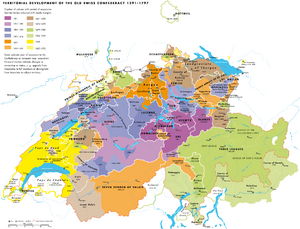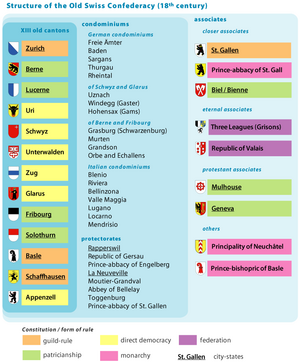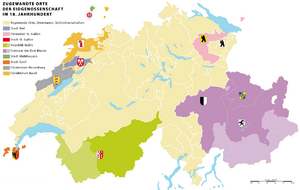الاتحاد السويسري القديم
Old Swiss Confederacy | |||||||||||||||||||||||||
|---|---|---|---|---|---|---|---|---|---|---|---|---|---|---|---|---|---|---|---|---|---|---|---|---|---|
| ح. 1300 – 1798 | |||||||||||||||||||||||||
 Swiss cross (field sign ح. 1470–1500) | |||||||||||||||||||||||||
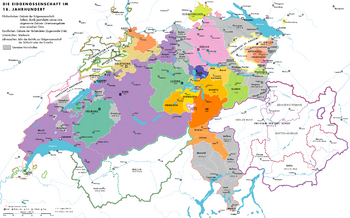 The Old Swiss Confederacy in the 18th century with modern Swiss national border (in red) | |||||||||||||||||||||||||
| العاصمة | None[4] | ||||||||||||||||||||||||
| اللغات الرسمية | German[5] | ||||||||||||||||||||||||
| اللغات المشتركة | Middle French / French, Alemannic German, Lombard, Rhaeto-Romansh[بحاجة لمصدر] | ||||||||||||||||||||||||
| الدين | Catholic Reformed | ||||||||||||||||||||||||
| الحكومة | Confederation | ||||||||||||||||||||||||
| التشريع | Tagsatzung | ||||||||||||||||||||||||
| التاريخ | |||||||||||||||||||||||||
• Death of Rudolf I | 15 July 1291 | ||||||||||||||||||||||||
| 1291 | |||||||||||||||||||||||||
| 1356 | |||||||||||||||||||||||||
| 13–14 September 1515 | |||||||||||||||||||||||||
| 1529 and 1531 | |||||||||||||||||||||||||
• Formal independence from the HRE | 15 May/24 October 1648 | ||||||||||||||||||||||||
| January–June 1653 | |||||||||||||||||||||||||
• Collapse | 5 March 1798 | ||||||||||||||||||||||||
| العملة | About 75 different local currencies, including Basel thaler, Berne thaler, Fribourg gulden, Geneva thaler, Geneva genevoise, Luzern gulden, Neuchâtel gulden, St. Gallen thaler, Schwyz gulden, Solothurn thaler, Valais thaler, Zürich thaler | ||||||||||||||||||||||||
| |||||||||||||||||||||||||
| جزء من سلسلة عن |
| تاريخ سويسرا |
|---|
 |
|
|
| ما قبل التاريخ |
| الفترة الرومانية (200 ق.م–400) |
| ألـِمانيا · برگنديا (400–900) |
| سوابيا · برگنديا (900–1300) |
|
|
| النمو (1291–1516) |
| الاصلاح (1516–1648) |
| النظام القديم (1648–1798) |
|
|
| عهد ناپليون (1798–1814) |
| الإحياء (1814–1847) |
|
|
| الدولة الفدرالية (1848) |
| الحروب العالمية (1914–1945) |
|
|
| التاريخ العسكري |
| خط زمني |
The Old Swiss Confederacy or Swiss Confederacy (Modern German: Alte Eidgenossenschaft; historically Eidgenossenschaft, after the Reformation also Corps des Suisses, Confoederatio helvetica "Confederation of the Swiss") was a loose confederation of independent small states (cantons, German Orte or Stände[6]) initially within the Holy Roman Empire. It is the precursor of the modern state of Switzerland.
It formed during the 14th century, from a nucleus in what is now Central Switzerland, expanding to include the cities of Zürich and Berne by the middle of the century. This formed a rare union of rural and urban communes, all of which enjoyed imperial immediacy in the Holy Roman Empire.
This confederation of eight cantons (Acht Orte) was politically and militarily successful for more than a century, culminating in the Burgundy Wars of the 1470s which established it as a power in the complicated political landscape dominated by France and the Habsburgs. Its success resulted in the addition of more confederates, increasing the number of cantons to thirteen (Dreizehn Orte) by 1513. The confederacy pledged neutrality in 1647 (under the threat of the Thirty Years' War), although many Swiss served privately as mercenaries in the Italian Wars and during the Early Modern period.
After the Swabian War of 1499 the confederacy was a de facto independent state throughout the early modern period, although still nominally part of the Holy Roman Empire until 1648 when the Treaty of Westphalia ended the Thirty Years' War. The Swiss Reformation divided the confederates into Reformed and Catholic parties, resulting in internal conflict from the 16th to the 18th centuries; as a result, the federal diet (Tagsatzung) was often paralysed by hostility between the factions. The Swiss Confederacy fell to invasion by the French Revolutionary Army in 1798, after which it became the short-lived Helvetic Republic.
Name
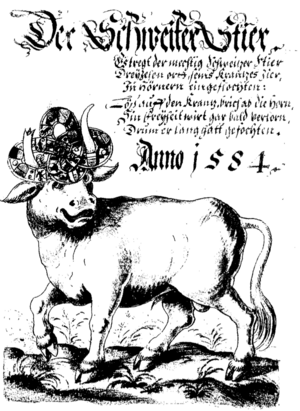
The adjective "old" was introduced after the Napoleonic era with Ancien Régime, retronyms distinguishing the pre-Napoleonic from the restored confederation. During its existence the confederacy was known as Eidgenossenschaft or Eydtgnoschafft ("oath fellowship"), in reference to treaties among cantons; this term was first used in the 1370 Pfaffenbrief. Territories of the confederacy came to be known collectively as Schweiz or Schweizerland (Schwytzerland in contemporary spelling), with the English Switzerland beginning during the mid-16th century. From that time the Confederacy was seen as a single state, also known as the Swiss Republic (Republic der Schweitzer, République des Suisses and Republica Helvetiorum by Josias Simmler in 1576) after the fashion of calling individual urban cantons republics (such as the Republics of Zürich, Berne and Basel).
History
Foundation
List of territories
Cantons
The confederation expanded in several stages: first to the Eight Cantons (Acht Orte), then in 1481 to ten, in 1501 to twelve, and finally to thirteen cantons (Dreizehn Orte).[7]
- Founding cantons (Urkantone):
 Uri, founding canton named in the Federal Charter of 1291
Uri, founding canton named in the Federal Charter of 1291 Schwyz, founding canton named in the Federal Charter of 1291
Schwyz, founding canton named in the Federal Charter of 1291 Unterwalden, founding canton named in the Federal Charter of 1291
Unterwalden, founding canton named in the Federal Charter of 1291
- 14th century: expansion to the Achtörtige Eidgenossenschaft following the battles of Morgarten and Laupen:
- 15th century: expansion to the Zehnörtige Eidgenossenschaft following the Burgundian Wars:
- 16th century: expansion to the Dreizehnörtige Eidgenossenschaft following the Swabian War:
 Basel, city canton, since 1501
Basel, city canton, since 1501 Schaffhausen, city canton, since 1501; associate since 1454
Schaffhausen, city canton, since 1501; associate since 1454 Appenzell, rural canton, since 1513; associate since 1411
Appenzell, rural canton, since 1513; associate since 1411
Associates
Associates (Zugewandte Orte) were close allies of the Old Swiss Confederacy, connected to the union by alliance treaties with all or some of the individual members of the confederacy.
Closest associates
Three of the associates were known as Engere Zugewandte:
 Biel – 1344–82 treaties with Fribourg, Berne and Solothurn. Nominally, Biel was subject to the Bishopric of Basel.
Biel – 1344–82 treaties with Fribourg, Berne and Solothurn. Nominally, Biel was subject to the Bishopric of Basel. Imperial Abbey of St. Gallen – 1451 treaty with Schwyz, Lucerne, Zürich and Glarus, renewed in 1479 and 1490. The abbey was simultaneously a protectorate.
Imperial Abbey of St. Gallen – 1451 treaty with Schwyz, Lucerne, Zürich and Glarus, renewed in 1479 and 1490. The abbey was simultaneously a protectorate. Imperial City of St. Gallen – 1454 treaty with Schwyz, Lucerne, Zürich, Glarus, Zug and Berne.
Imperial City of St. Gallen – 1454 treaty with Schwyz, Lucerne, Zürich, Glarus, Zug and Berne.
Eternal associates
Two federations were known as Ewige Mitverbündete:
 Sieben Zenden, an independent federation in the Valais – Became a Zugewandter Ort in 1416 through an alliance with Uri, Unterwalden and Lucerne, followed by a treaty with Berne in 1446.
Sieben Zenden, an independent federation in the Valais – Became a Zugewandter Ort in 1416 through an alliance with Uri, Unterwalden and Lucerne, followed by a treaty with Berne in 1446.- Three Leagues were independent federations on the territory of the Grisons and became an associates of the Old Swiss Confederacy in 1497/98 through the events of the Swabian War. The Three Leagues together concluded an alliance pact with Berne in 1602.
 Grey League, who had been allied with Glarus, Uri and Obwalden through pacts from 1400, 1407 and 1419, entered an alliance with seven of the old eight cantons (the Acht Orte without Berne) in 1497
Grey League, who had been allied with Glarus, Uri and Obwalden through pacts from 1400, 1407 and 1419, entered an alliance with seven of the old eight cantons (the Acht Orte without Berne) in 1497 League of God's House (Gotteshausbund) followed suit a year later.
League of God's House (Gotteshausbund) followed suit a year later. League of the Ten Jurisdictions, the third of the leagues, entered an alliance with Zürich and Glarus in 1590.
League of the Ten Jurisdictions, the third of the leagues, entered an alliance with Zürich and Glarus in 1590.
Protestant associates
There were two Evangelische Zugewandte:
 Imperial City of Mulhouse – Concluded a first treaty with some cantons in 1466 and became an associate in 1515 through a treaty with all 13 members of the Confederacy, remaining so until events of the French Revolutionary Wars in 1797.
Imperial City of Mulhouse – Concluded a first treaty with some cantons in 1466 and became an associate in 1515 through a treaty with all 13 members of the Confederacy, remaining so until events of the French Revolutionary Wars in 1797. Imperial City of Geneva – 1536 treaty with Berne and a 1584 treaty with Zürich and Berne.
Imperial City of Geneva – 1536 treaty with Berne and a 1584 treaty with Zürich and Berne.
Other
 County of Neuchâtel – 1406 and 1526 treaties with Berne and Solothurn, 1495 treaty with Fribourg and 1501 treaty with Lucerne.
County of Neuchâtel – 1406 and 1526 treaties with Berne and Solothurn, 1495 treaty with Fribourg and 1501 treaty with Lucerne. Imperial Valley of Urseren – 1317 treaty with Uri; annexed by Uri in 1410.
Imperial Valley of Urseren – 1317 treaty with Uri; annexed by Uri in 1410. Weggis – 1332–1380 by treaties with Uri, Schwyz, Unterwalden and Lucerne; annexed by Lucerne in 1480.
Weggis – 1332–1380 by treaties with Uri, Schwyz, Unterwalden and Lucerne; annexed by Lucerne in 1480. Murten – from 1353 by treaty with Berne; became a confederal condominium in 1475.
Murten – from 1353 by treaty with Berne; became a confederal condominium in 1475. Payerne – from 1353 by treaty with Berne; annexed by Berne in 1536.
Payerne – from 1353 by treaty with Berne; annexed by Berne in 1536. County of Sargans – from 1437 by treaty with Glarus and Schwyz; became a confederal condominium in 1483.
County of Sargans – from 1437 by treaty with Glarus and Schwyz; became a confederal condominium in 1483. Barony of Sax-Forstegg – from 1458 by treaty with Zürich; annexed by Zürich in 1615
Barony of Sax-Forstegg – from 1458 by treaty with Zürich; annexed by Zürich in 1615 Stein am Rhein – from 1459 by treaty with Zürich and Schaffhausen; annexed by Zürich in 1484.
Stein am Rhein – from 1459 by treaty with Zürich and Schaffhausen; annexed by Zürich in 1484. County of Gruyère – had been allied with Fribourg and Berne since the early 14th century, becoming a full associate of the Confederation in 1548. When the counts fell bankrupt in 1555, the country was partitioned in twain:[8]
County of Gruyère – had been allied with Fribourg and Berne since the early 14th century, becoming a full associate of the Confederation in 1548. When the counts fell bankrupt in 1555, the country was partitioned in twain:[8]
- Lower Gruyère – from 1475 by treaty with Fribourg
- Upper Gruyère – from 1403 by treaty with Berne; annexed by Berne in 1555:
 Imperial Valley of Saanen
Imperial Valley of Saanen Imperial Valley of Château-d'Œx
Imperial Valley of Château-d'Œx
 County of Werdenberg – from 1493 by treaty with Lucerne; annexed by Glarus in 1517.
County of Werdenberg – from 1493 by treaty with Lucerne; annexed by Glarus in 1517. Imperial City of Rottweil – from 1519–1632 through a treaty with all 13 members; a first treaty on military cooperation had already been concluded in 1463. In 1632, the treaty was renewed with Lucerne, Uri, Schwyz, Unterwalden, Zug, Solothurn and Fribourg.
Imperial City of Rottweil – from 1519–1632 through a treaty with all 13 members; a first treaty on military cooperation had already been concluded in 1463. In 1632, the treaty was renewed with Lucerne, Uri, Schwyz, Unterwalden, Zug, Solothurn and Fribourg. Bishopric of Basel – 1579–1735 by treaty with Lucerne, Uri, Schwyz, Unterwalden, Zug, Solothurn and Fribourg.
Bishopric of Basel – 1579–1735 by treaty with Lucerne, Uri, Schwyz, Unterwalden, Zug, Solothurn and Fribourg.
Condominiums
Condominiums (ألمانية: Gemeine Herrschaften) were common subject territories under the administration of several cantons. They were governed by reeves (Vögte) delegated for two years, each time from another of the responsible cantons. Berne initially did not participate in the administration of some of the eastern condominiums, as it had no part in their conquest and its interests were focused more on the western border. In 1712, Berne replaced the Catholic cantons in the administration of the Freie Ämter ("Free Districts"), the Thurgau, the Rhine valley, and Sargans, and furthermore the Catholic cantons were excluded from the administration of the County of Baden.[9]
German bailiwicks
The "German bailiwicks" (ألمانية: Deutsche Gemeine Vogteien, Gemeine Herrschaften) were generally governed by the Acht Orte apart from Berne until 1712, when Bern joined the sovereign powers:
 Freie Ämter – conquered 1415 and partitioned in 1712:
Freie Ämter – conquered 1415 and partitioned in 1712:
- Upper Freiamt was governed by the Acht Orte;
- Lower Freiamt was governed by Zürich, Bern and Glarus alone.
 County of Baden – conquered 1415; from 1712 governed by Zürich, Bern and Glarus.
County of Baden – conquered 1415; from 1712 governed by Zürich, Bern and Glarus. County of Sargans – from 1460/83
County of Sargans – from 1460/83 Landgraviate of Thurgau – from 1460
Landgraviate of Thurgau – from 1460 Vogtei of Rheintal – from 1490, Acht Orte minus Bern, plus the Imperial Abbey of St Gall. Appenzell added in 1500; Berne added in 1712.
Vogtei of Rheintal – from 1490, Acht Orte minus Bern, plus the Imperial Abbey of St Gall. Appenzell added in 1500; Berne added in 1712.
Italian bailiwicks
Several bailiwicks (Vogteien) were generally referred to as "transmontane bailiwicks" (ألمانية: Ennetbergische Vogteien, إيطالية: Baliaggi Ultramontani). In 1440, Uri conquered the Leventina Valley from the Visconti, dukes of Milan. Some of this territory had previously been annexed between 1403 and 1422. Further territories were acquired in 1500; see History of Ticino for further details.
Three bailiwicks, all now in the Ticino, were condominiums of the Forest cantons of Uri, Schwyz and Nidwalden:
- Vogtei of Blenio – 1477–80 and from 1495
- Vogtei of Rivera – 1403–22 and from 1495
- Vogtei of Bellinzona – from 1500
Four other Ticinese bailiwicks were condominiums of the Zwölf Orte (the original 13 cantons, minus Appenzell) from 1512:
Another three bailiwicks were condominiums of the Zwölf Orte from 1512, but were lost from the Confederacy three years later and are all now comuni of Lombardy:
Two-party condominiums
Bern and Fribourg
 County of Grasburg / Schwarzenburg – from 1423
County of Grasburg / Schwarzenburg – from 1423 Murten – from 1475
Murten – from 1475 Grandson – from 1475
Grandson – from 1475 Orbe and Echallens – from 1475
Orbe and Echallens – from 1475
Glarus and Schwyz
 Uznach – from 1437
Uznach – from 1437 , Windegg / Gaster – from 1438
, Windegg / Gaster – from 1438 Hohensax / Gams – from 1497
Hohensax / Gams – from 1497
Condominiums with third-parties
- Lordship of Tessenberg – from 1388, condominium between Berne and Bishopric of Basel
Protectorates
 Bellelay Abbey – protectorate of Bern, Biel and Solothurn from 1414; nominally under the jurisdiction of the Bishopric of Basel
Bellelay Abbey – protectorate of Bern, Biel and Solothurn from 1414; nominally under the jurisdiction of the Bishopric of Basel Einsiedeln Abbey – protectorate of Schwyz from 1357
Einsiedeln Abbey – protectorate of Schwyz from 1357 Engelberg Abbey – protectorate of Lucerne, Uri, Schwyz and Unterwalden from 1425
Engelberg Abbey – protectorate of Lucerne, Uri, Schwyz and Unterwalden from 1425 Erguel – protectorate of Biel/Bienne under military jurisdiction from 1335; also subject to the Bishopric of Basel
Erguel – protectorate of Biel/Bienne under military jurisdiction from 1335; also subject to the Bishopric of Basel Imperial Abbey of St. Gallen – protectorate of Schwyz, Lucerne, Zürich and Glarus from 1451; the abbey was simultaneously a Zugewandter Ort.
Imperial Abbey of St. Gallen – protectorate of Schwyz, Lucerne, Zürich and Glarus from 1451; the abbey was simultaneously a Zugewandter Ort. Republic of Gersau, an independent village – allied with Schwyz since 1332; Lucerne, Uri and Unterwalden were also protecting powers.
Republic of Gersau, an independent village – allied with Schwyz since 1332; Lucerne, Uri and Unterwalden were also protecting powers. Moutier-Grandval Abbey – protectorate of Berne from 1486; the abbey was also subject to the Bishopric of Basel and, until 1797, the Holy Roman Empire
Moutier-Grandval Abbey – protectorate of Berne from 1486; the abbey was also subject to the Bishopric of Basel and, until 1797, the Holy Roman Empire La Neuveville – protectorate of Berne from 1388; also subject to the Bishopric of Basel.
La Neuveville – protectorate of Berne from 1388; also subject to the Bishopric of Basel. Pfäfers Abbey – protectorate of the Acht Orte minus Berne from 1460; annexed to the County of Sargans in 1483
Pfäfers Abbey – protectorate of the Acht Orte minus Berne from 1460; annexed to the County of Sargans in 1483 Rapperswil – protectorate of Uri, Schwyz, Unterwalden and Glarus from 1464; of Zürich, Berne and Glarus from 1712
Rapperswil – protectorate of Uri, Schwyz, Unterwalden and Glarus from 1464; of Zürich, Berne and Glarus from 1712 County of Toggenburg – protectorate of Schwyz and Glarus from 1436; of Zürich and Berne from 1718. The county was simultaneously subject to St Gallen Abbey.
County of Toggenburg – protectorate of Schwyz and Glarus from 1436; of Zürich and Berne from 1718. The county was simultaneously subject to St Gallen Abbey.
Separate subjects
Some territories were separate subjects of cantons or associates, Einzelörtische Untertanen von Länderorten und Zugewandten:
Uri
Schwyz
 Küssnacht (1402)
Küssnacht (1402) Einsiedeln Abbey (1397 / 1424)
Einsiedeln Abbey (1397 / 1424) March (1405 / 36)
March (1405 / 36) Höfe (1440)
Höfe (1440)
Glarus
 County of Werdenberg (1485 / 1517); annexed to Lucerne in 1485; to Glarus in 1517
County of Werdenberg (1485 / 1517); annexed to Lucerne in 1485; to Glarus in 1517
Valais
 St-Maurice (1475 / 77)
St-Maurice (1475 / 77) Monthey (1536)
Monthey (1536) Nendaz-Hérémence (1475 / 77)
Nendaz-Hérémence (1475 / 77) Port Valais/Vionnaz
Port Valais/Vionnaz- Lötschental (15th century); the five upper Zenden
Three Leagues
 Bormio (1512)
Bormio (1512)- Chiavenna (1512)
- Valtellina (1512)
- Drei Pleven (1512–26)
 Maienfeld (Bündner Herrschaft) (1509–1790); simultaneously a member of the League of the Ten Jurisdictions.
Maienfeld (Bündner Herrschaft) (1509–1790); simultaneously a member of the League of the Ten Jurisdictions.
Notes and references
- ^ Corpus helveticum, in the Historical Dictionary of Switzerland.
- ^ Corps helvétique, in the Historical Dictionary of Switzerland.
- ^ أ ب Corpo helvetico, in the Historical Dictionary of Switzerland.
- ^ Kaufmann, David (2018). "4. Bern: the government city". Varieties of Capital Cities. Edward Elgar Publishing. ISBN 9781788116435.
- ^ Ayres-Bennett, Wendy; Carruthers, Janice (2018). Manual of Romance Sociolinguistics. De Gruyter. p. 529. ISBN 9783110365955.
- ^ In the charters of the 14th century described as "communities" (communitas hominum, Lantlüte), the German term Orte becomes common in the early 15th century, used alongside Stand "estate" after the Reformation. The French term canton is used in Fribourg in 1475, and after 1490 is increasingly used in French and Italian documents. It only enters occasional German usage after 1648, and only gains official status as synonym of Stand with the Act of Mediation of 1803. Kantone in German, French and Italian in the online Historical Dictionary of Switzerland. Version of 2016.
- ^ Im Hof, U.. Geschichte der Schweiz, 7th ed., Stuttgart: W. Kohlhammer, 1974/2001. ISBN 3-17-017051-1. (in ألمانية)
- ^ Boschetti-Maradi, A.: County of Gruyère in German, French and Italian in the online Historical Dictionary of Switzerland. Version of 2004-06-28.
- ^ خطأ استشهاد: وسم
<ref>غير صحيح؛ لا نص تم توفيره للمراجع المسماةeidg
للاستزادة
- Aubert, J.-F.: Petite histoire constitutionnelle de la Suisse, 2nd ed.; Francke Editions, Bern, 1974. (in فرنسية)
- Peyer, H. C.: Verfassungsgeschichte der alten Schweiz, Schulthess Polygraphischer Verlag, Zürich, 1978. ISBN 3-7255-1880-7. (in ألمانية)
وصلات خارجية
 Media related to Alte Eidgenossenschaft (Old Swiss Confederacy) at Wikimedia Commons
Media related to Alte Eidgenossenschaft (Old Swiss Confederacy) at Wikimedia Commons
- Articles containing لاتينية-language text
- Articles containing ألمانية-language text
- Articles containing فرنسية-language text
- Articles with ألمانية-language sources (de)
- Short description is different from Wikidata
- Articles containing إيطالية-language text
- Articles with unsourced statements from December 2021
- Pages using infobox country or infobox former country with the flag caption or type parameters
- Portal-inline template with redlinked portals
- Pages with empty portal template
- Articles with hatnote templates targeting a nonexistent page
- Pages using Lang-xx templates
- Articles with فرنسية-language sources (fr)
- Switzerland articles missing geocoordinate data
- All articles needing coordinates
- Old Swiss Confederacy
- States and territories established in 1291
- States and territories disestablished in 1798
- Medieval Switzerland
- Early Modern history of Switzerland
- Former confederations
- Former countries in Europe
- States of the Holy Roman Empire
- 1290s establishments in the Holy Roman Empire
- 1291 establishments in Europe
- 1798 disestablishments in Europe
- 13th-century establishments in the Old Swiss Confederacy
- 18th-century disestablishments in the Old Swiss Confederacy
- Former countries
- History of Switzerland by period
- 2nd millennium in Switzerland
